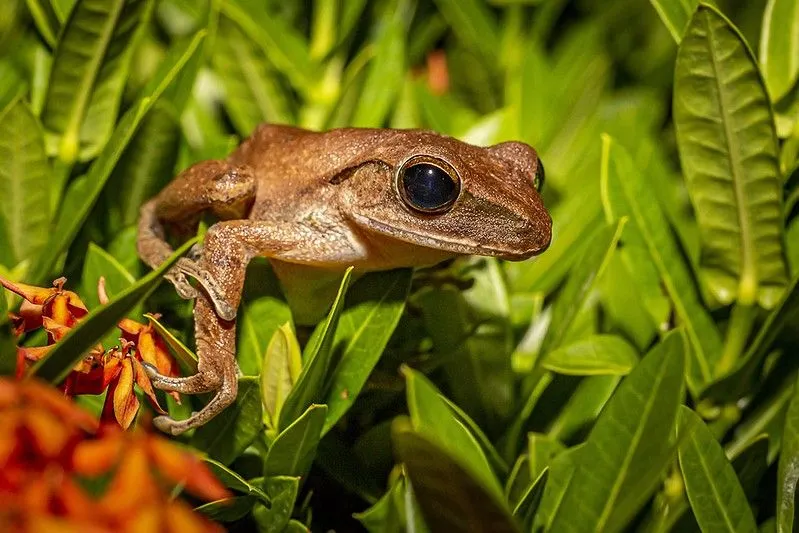FOR ALL AGES
Wildlife is everywhere. You don’t need to go down to the woods, or visit the coast to see it. Even those of us in apartments without gardens can get a nature fix without leaving the house. It’s all about keeping your eyes open and knowing what to look for. Here are nine tips to rewild your home.
One of the simplest and cheapest ways to attract bird life to your home is to buy or make a bird feeder. You can pick these up at garden centres and some supermarkets for very little money. Alternatively, you could craft your own. One very simple design is to take an old toilet roll or kitchen roll cardboard tube, coat it in peanut butter, then roll this in seeds. This method can be adapted to other materials, such as pine cones or egg cups. We’ve put together a selection of 12 homemade bird feeders in this article. Bird feeders are most attractive in gardens, but families with balconies or a roof terrace might also get extra visitors. We sometimes put seeds out on our balcony ledge five floors up, and it always attracts someone, even if it is just a magpie.
Small birds like sparrows and tits sometimes struggle to find nesting sites in the urban environment, as hedgerows get nibbled away by developments. If every garden had its own birdbox, our feathered friends would have plenty more options. Building a bird box is reasonably easy, as outlined in this article, but is an activity best suited to older children with adult supervision. You will need a garden for this one, preferably one large enough to have a sheltered quiet space away from windows and other distractions.
Minibeast are everywhere. Lift the carpet, empty the cupboard, raise a plant pot… chances are you’ll find some kind of insect, arachnid or arthropod. If you’ve got a garden, their numbers will be legion. Instead of screwing up our faces and saying ‘yuck’, we should pay more attention to these remarkable creatures. A good way to build interest is to start a minibeast diary. Every time you encounter a little creature, observe its behaviour, take photographs, try to identify it with a book or internet guide, then note everything down in your minibeast diary. The project can be surprisingly addictive, and you’ll learn to love, not loathe, your tiny housemates. Once you’ve discovered the joy of bugs, consider visiting these activity centres to learn more (UK).
You certainly don’t need a garden to appreciate the wildlife moving through our skies. You might even be able to do this one from your bed or sofa. All you have to do is pay more attention to what’s flying overhead. Set aside a block of time and do nothing except observe the passing birds. You might assume it’ll be little more than just gulls, starlings and crows but the practiced eye will pick out much more besides. I tried it this morning and, in the space of 15 minutes, spotted two red kites, a pair of wagtails and a flock of parakeets, besides all the common birds -- and that’s from a flat in north London. If you live somewhere rural or in a village, then the potential sightings are even more exciting. Look out for bats in the twilight, too, of course.
The more flowers you can pack into your garden, balcony or window box, the better. Not only will the blooms beautify your home, but you’ll also be giving a boost to wildlife. Insects such as bees and butterflies will appreciate the extra food sources, and you can enjoy watching them going about their business. Planting native species is, quite obviously, most likely to attract native wildlife. Climbing plants and berry-bearing hedges are a good option for those with gardens, as they provide habitat for smaller creatures and sheltered perching or nesting for small birds. Plants such as verbena and scabious are particularly important to butterflies.
Speaking of butterflies, have you ever tried building a butterfly feeder? Our colourful friends are readily attracted to sweetened water. Simply dissolve one part sugar in ten parts water then soak it into a brightly coloured sponge. Hang the sponge up somewhere, and it should attract any passing butterflies. Those who are really keen to learn more about lepidoptera might also consider getting hold of a moth trap. These use a bright light to attract night-flying moths, which are then contained (harmlessly) in a plastic chamber. Moth traps can be a bit on the pricey side, but there’s no better way to study these abundant but mostly unseen insects.

Families with any kind of garden should consider digging a pond. Even small gardens can accommodate something useful. There are few better strategies to attract interesting wildlife to your plot. You’ll be amazed just how readily frogs and even toads will find their way into an urban garden pond. Look out for frogspawn in the spring. In summer, you’ll be more likely to see dragonflies and other aerial pond species buzzing around the garden. Even a bucket of water, left alone, can become a haven for wildlife. An empty planter on my block’s roof terrace filled with rain water over autumn and came to be teeming with nymphs -- all six floors up. It almost goes without saying, but be careful with ponds if you have a toddler running around.
If you have a garden surrounded by brick walls or hard fencing, then you’re going to keep out pretty much anything that can’t fly. The simple, environmentally friendly solution is to replace such barriers with hedges or conifers. These allow creatures such as hedgehogs to move freely from garden to garden in search of food (which you could leave out). You’ll also find that your pond soon attracts occupants if your borders are open to amphibious assault.
Enjoying wildlife isn’t only about using your eyes. Sit in your garden, or merely at a window, close your eyes and simply listen. It’ll take a few minutes to attune to the sounds around you but, with time, you’ll start to pick out whistles, scratches and rhythms you never knew were there. Birdsong is the most obvious natural sound. Even from a city centre, you should be able to pick out the songs and calls of up to a dozen species. Use online audio guides to learn how to distinguish the different sounds. Don’t despair if it takes a while to get the hang of ID-ing a bird by its call. It takes time and practice, but it’s a rewarding learning curve. Listen out, too, for the short drilling sounds of woodpeckers (particularly in early spring), the tell-tale undergrowth rustle of the blackbird, and the unmistakable maudlin, nocturnal cry of the fox.
Read The Disclaimer
At Kidadl we pride ourselves on offering families original ideas to make the most of time spent together at home or out and about, wherever you are in the world. We strive to recommend the very best things that are suggested by our community and are things we would do ourselves - our aim is to be the trusted friend to parents.
We try our very best, but cannot guarantee perfection. We will always aim to give you accurate information at the date of publication - however, information does change, so it’s important you do your own research, double-check and make the decision that is right for your family.
Kidadl provides inspiration to entertain and educate your children. We recognise that not all activities and ideas are appropriate and suitable for all children and families or in all circumstances. Our recommended activities are based on age but these are a guide. We recommend that these ideas are used as inspiration, that ideas are undertaken with appropriate adult supervision, and that each adult uses their own discretion and knowledge of their children to consider the safety and suitability.
Kidadl cannot accept liability for the execution of these ideas, and parental supervision is advised at all times, as safety is paramount. Anyone using the information provided by Kidadl does so at their own risk and we can not accept liability if things go wrong.
Kidadl is independent and to make our service free to you the reader we are supported by advertising.
We hope you love our recommendations for products and services! What we suggest is selected independently by the Kidadl team. If you purchase using the buy now button we may earn a small commission. This does not influence our choices. Please note: prices are correct and items are available at the time the article was published.
Kidadl has a number of affiliate partners that we work with including Amazon. Please note that Kidadl is a participant in the Amazon Services LLC Associates Program, an affiliate advertising program designed to provide a means for sites to earn advertising fees by advertising and linking to amazon.
We also link to other websites, but are not responsible for their content.
Was this article helpful?



Browse Category



We’ll send you tons of inspiration to help you find a hidden gem in your local area or plan a big day out.



Check your inbox for your latest news from us. You have subscribed to:
Remember that you can always manage your preferences or unsubscribe through the link at the foot of each newsletter.